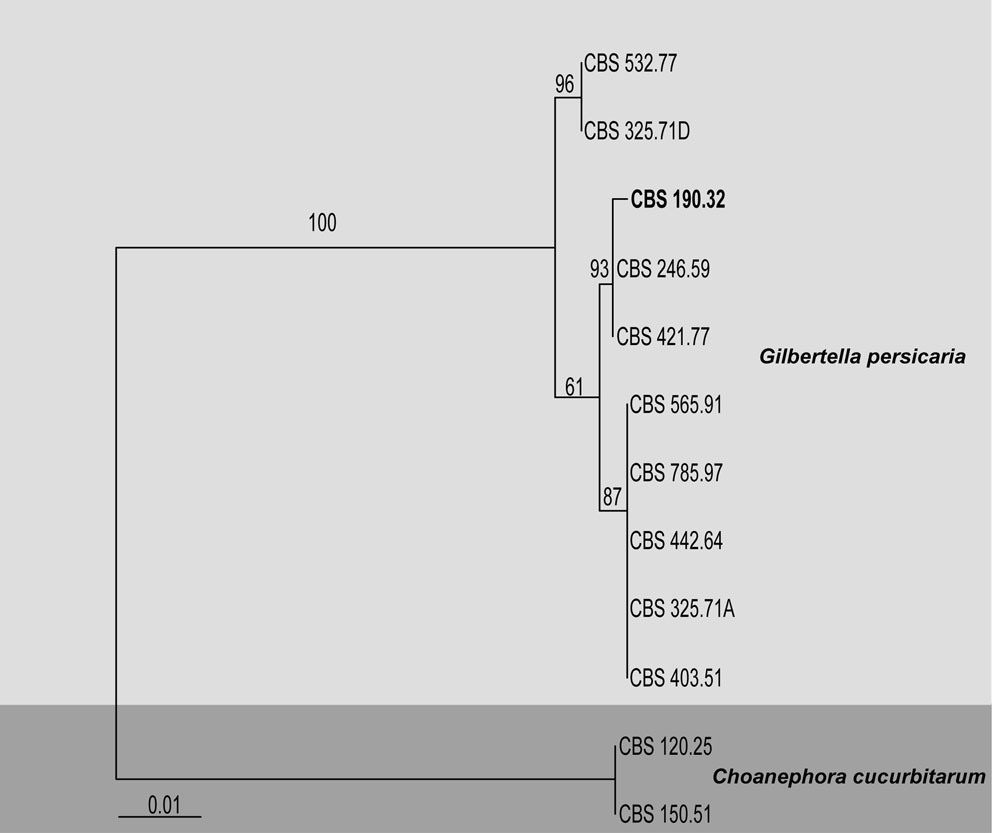23 Oct Gilbertella
Gilbertella
Background
The monotypic genus Gilbertella belongs to the family Choanephoraceae and subfamily Gilbertelloideae (Mucorales, former Zygomycota). It was established by Hesseltine (1960) for species described earlier as Choanephora persicaria by Eddy (1925), and consequently, the type species of the genus is Gilbertella persicaria. Benny (1991) proposed a new family, Gilbertellaceae to accommodate this genus. Currently, the genus belongs to the family Choanephoraceae and subfamily Gilbertelloideae that can be distinguished from Choanephoroideae (Voigt and Kirk 2012) by ornamented zygospores and opposed suspensors (Voigt 2012). Although G. persicaria was originally described as Choanephora persicaria (Eddy 1925), its separate position within the family has been confirmed in several studies (Papp et al. 2003; Hoffmann et 2013).
In tropical and subtropical regions Gilbertella is a common postharvest pathogen, causing rots of pears (Mehrotra 1963a), peaches (Hesseltine 1960; Mehrotra 1963b; Ginting et al. 1996) and tomatoes (Mehrotra 1966). It was reported by Butler et al. (1960) and Hesseltine (1960) from mulberry (Morus sp.) in the USA. It was also recently isolated from pitaya fruits (Hylocereus undatus, Cactaceae) in Japan (Taba et al. 2011) and China (Guo et al. 2012).
Species identification and numbers
Currently, Gilbertella persicaria is the only species within the genus. Although another species–Gilbertella hainanensis–has been described (Cheng and Hu 1965), after recent molecular studies of its ITS sequence, it is not currently recognized as a separate species (Walther et al. 2013). Two varieties of G. persicaria have been described: G. persicaria var. persicaria and G. persicaria var. indica, however only the former was accepted in the monograph published by Benny (1991).
Gilbertella persicaria produces sporangia with a persistent wall that ruptures at preformed sutures in two halves. Ellipsoid, smooth-walled, hyaline sporangiospores with polar appendages are released in a droplet of fluid. Light brown ornamented zygospores are formed on opposed suspensors (Hesseltine 1960). The examination of morphology is usually enough for correct species identification. Moreover, morphological identification may be easily confirmed by ITS sequencing (Table, Fig.).
Table Gilbertella. Details of the isolates used in the phylogenetic tree
| Species
Gilbertella persicaria |
Isolate
CBS 190.32* |
Host
Prunus persica |
GenBank no
HM999958 |
| G. persicaria | CBS 785.97 | – | JN206218 |
| G. persicaria | CBS 442.64 | – | JN206219 |
| G. persicaria | CBS 325.71A | Saccharum officinarum | JN206220 |
| G. persicaria | CBS 403.51 | – | JN206221 |
| G. persicaria | CBS 246.59 | Trickling filter plant system | JN206222 |
| G. persicaria | CBS 421.77 | Soil | JN206223 |
| G. persicaria | CBS 532.77 | Dung of mouse | JN206224 |
| G. persicaria | CBS 325.71D | Wood | JN206225 |
| G. persicaria | CBS 565.91 | Dung of swine | JN206226 |
| Choanephora cucurbitarum | CBS 120.25 | – | JN206231 |
| C. cucurbitarum | CBS 150.51 | – | JN206232 |
Ex-type (ex-epitype) strains are bolded and marked with an * and voucher strains are bolded
Fig. Phylogram generated from Maximum likelihood analysis based on ITS sequenced data of Gilbertella. Bootstrap support values greater than 50 % are indicated above the nodes. The ex-type (ex-epitype) and voucher strains are in bold
Molecular phylogeny
The phylogenetic relationships based on the complete ITS region of Gilbertella representatives and related Mucorales taxa were completed by Papp et al. (2003). All Gilbertella cultures available in the CBS culture collection have been sequenced for their ITS region and were included in a molecular analysis by Walther et al. (2013). These studies showed that the universal fungal DNA barcoding marker–the ITS region (Schoch et al. 2012)–is sufficient for Gilbertella species identification (Fig. 16). The multi-marker phylogenetic analysis including representatives of this genus performed by Hoffmann et al. (2013), confirmed a distinct, well-supported position of Gilbertella within Choanephoraceae family.
Recommended genetic markers
- The internal transcribed spacer (ITS) region–generic and species level
The large and small subunits (LSU and SSU) of nrDNA– placement within the Mucorales order, higher-level phylogeny


No Comments